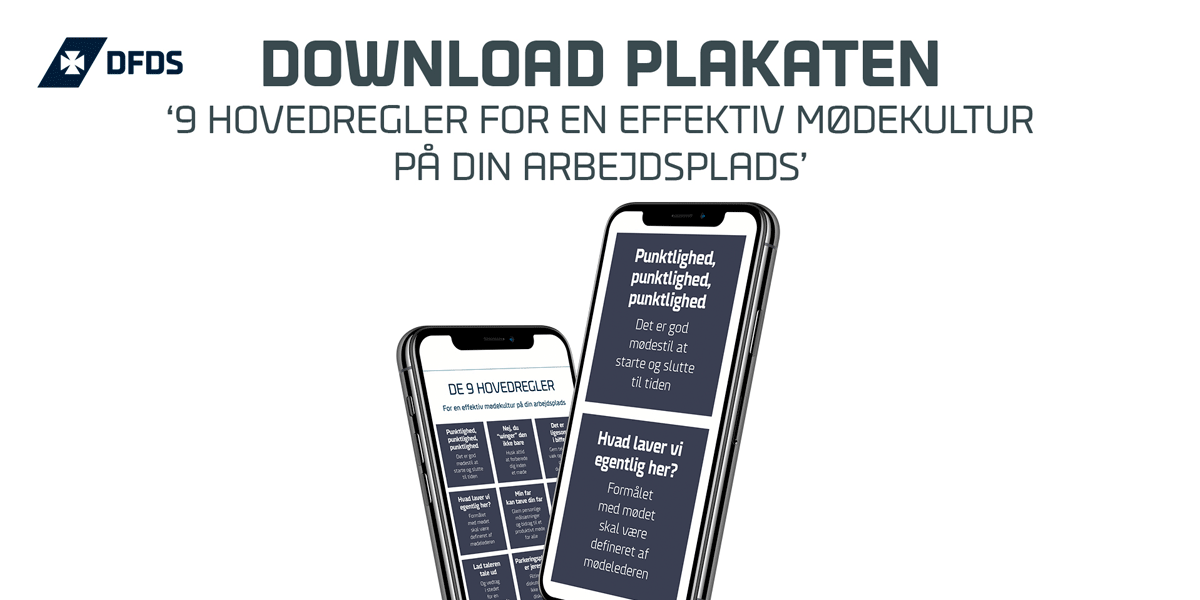
Avoid costly meeting bibs: this is what you need to do to hold effective meetings
37 billion dollars. Or in the region of 250 billion kroner.
According to a group of researchers, led by the acclaimed professor Steven Rogelberg of the University of North Carolina, it is the absurd sum that is lost every year because American companies suffer from an inefficient meeting culture.
Do Danish workplaces have a similar problem?
Unfortunately, surveys suggest that the answer is yes. For example, the estimate in 2010 was millions of wasted meeting kroner annually in the Danish business community. Since then, our meeting culture has hardly improved. In 2019, a survey showed that 80 per cent. of HK’s members every week wastes time at regular meetings.
More meetings and good intentions
How in the world can inefficient meetings constitute a million cost for Danish companies?
To become wiser about both inefficient and efficient meeting culture, we have taken a talk with Line Ullmann. She teaches effective meetings at the Danish Technological Institute and has taught both public and private companies how to create a better meeting culture.
Line Ullmann does not think it is intentional when employees waste meeting time. On the other hand, it is her clear impression that the average Danish employee participates in more meetings today than before.
An increasing proportion of Danish workplaces are knowledge workplaces. And the basic purpose of meetings is knowledge sharing and knowledge gathering. More knowledge generates more meetings, and thus also an increased risk of ineffective meetings.
“When I talk to employees of the country's companies, there is no doubt: Many people find that meetings quietly take over their calendar. It is a challenge, because the time to prepare for the meetings does not necessarily follow. There is this feeling of a meeting culture that does not work optimally, but there is no time to consider how we can hold the meetings in a more efficient way,” says Line Ullmann.
What am I really doing here?
Of course, it's obvious to get a tip or two. Hear what Line Ullmann tells the companies and the other big players when they ask for her help in holding better meetings.
But before we get there, let's dwell for a moment on the bad encounter. That's where the dog is buried. Exactly what goes wrong with the bad meeting?
"What characterizes an effective meeting is that the majority of the content is relevant to the majority of the participants. Otherwise, the meeting is not effective. This is what often goes wrong. We are sitting in on a meeting, but it is really only one or two items on the agenda that concern us. You start asking yourself: What am I doing here? You might write an email instead of following the meeting. It is really an attempt to use your time efficiently. Unfortunately, the result is that you do not get anything out of the meeting, you do not contribute to the meeting, and you probably do not write a particularly good email because you try to multitask,” says Line Ullmann.
When meeting participants shift focus, it has a negative effect on all parties involved. Although the intention is good enough. It is about nonverbal communication. The meeting participant who has the floor can see and sense if the interest in the room decreases.
The person becomes insecure about himself, and may even return the service when another meeting participant has the floor. Not as revenge, but because a distinctly selective attention becomes an integral part of the meeting culture.
A plan for effective meetings
Too much meeting time where the individual meeting participant is not sufficiently engaged. Too much inattention. And too little preparation time. In short, this is the recipe for an inefficient meeting culture. Now the question is: How do companies get their meeting culture back on track?
“To begin with, all companies should agree that we only convene a meeting if there is a completely clear purpose to the meeting. Here it is important to know the difference between purpose and process and strong and weak meeting purposes. For example, it is not a meeting purpose to have to discuss anything. Discussing something is an example of a weak meeting goal and it does not work very well when the meeting is to be managed,” says Line Ullmann.
A strong meeting purpose can, for example, be to prioritize limited resources, adopt a concrete action plan or develop ideas for a concrete task solution. There must be a concrete output of the meeting. A product.
A concrete purpose of a meeting may also be that a group of people should leave a meeting with a new level of knowledge or a sense of common ground and motivation. A specific physical product may not come out of that meeting, but it is clear what the participants need to achieve with the meeting.
"We must actually avoid weak meeting goals such as 'we meet to discuss the declining sales figures' and instead formulate strong meeting goals such as 'We meet to agree on 5 measures that can lift the falling sales," says Line Ullmann.
Who will attend the effective meeting?
Another important principle concerns the meeting participants. This is because it should preferably be the case that the employees who participate use their meeting time efficiently from start to finish.
“I would definitely recommend companies to raise awareness about who is being called to meetings. Participants must contribute something concrete or have a concrete benefit from their entire meeting time. If it's just very nice that a participant is sitting with and nothing else, he or she could probably spend his or her time better on something else,” says Line Ullmann.
The convening of the meeting may advantageously include a brief description of the various participants' contributions to the meeting. Who bids with what and when? Incidentally, meeting participants can easily leave a meeting along the way. There is no shame if you have solved your task for the meeting.
Physical setting and no encounters at all
An effective meeting culture is about two things in particular:
- Only hold meetings with a clear purpose
- Invite only those participants who are to contribute information or receive information. By the way, let participants leave the meeting along the way when their task is solved.
We end the interview by asking about the near future. According to Line Ullmann, what will be one of the major trends in effective meeting culture?
“I think one of the big trends will be nudging. Encourage a more effective meeting culture instead of setting a lot of rules. It is about creating a framework, both digital and physical, which helps employees to achieve effective meeting time,” says Line Ullmann.
As an example, she mentions two very tangible ones - a digital and a physical nudge:
- Adjustment of standard meeting lengths. Many digital calendar systems operate with half an hour and a full hour as standard meeting lengths. As a consequence, employees risk delays when they have two or more meetings in succession. Therefore: Adjust the standard meeting length in your calendar system to 20 minutes and 50 minutes respectively. That way, employees get a buffer of ten minutes to reach from one meeting to the next. It minimizes delays and thus increases meeting efficiency.
- Out with chairs and tables: This one is even simpler. You simply have to remove chairs and tables from meeting rooms. Not all of them meeting rooms, and maybe not all the time, but sometimes. A meeting room without chairs and tables encourages more efficient meeting time.
Should employees be in doubt about the carrot, they can just look in the direction of the Danish company IHH Nordic. A four-day working week has been introduced here. How is that possible? Among other things, by reducing the time spent on meetings and improving the quality of meetings.
Another thought-provoking example is Systematic. The Aarhus-based software company decided at the beginning of 2020 to delete all meetings in the calendar. One simply needed to shake the bag and do something drastic in relation to meetings, the director explained. In future, the company's meetings must "be standing, they must not last more than 30 minutes, and then there should be a maximum of five participants".
When it comes to the effective meeting culture, there are a whole lot of exciting initiatives in the Danish business community. The most important thing, in fact, is to be critical of whether your company uses your meeting time well enough.

9 MAIN RULES FOR AN EFFICIENT MEETING CULTURE AT YOUR WORKPLACE
Do you want more out of your meetings? Give yourself and your colleagues a daily reminder of the recipe for the good meeting with this poster, which lists 9 main rules for an effective meeting culture in the workplace.
Download the poster now

MEETINGS AND CONFERENCES AT SEA
Do you want to hold a meeting or conference that is a little out of the ordinary? Then take the Oslo boat from Copenhagen, and experience an exciting alternative to the traditional conference centers.
Do you want to increase the results and sharpen the relations at the next business meeting, conference and company event? Our modern and spacious ships offer unique and unforgettable surroundings for all kinds of business meetings, conferences and corporate events.
